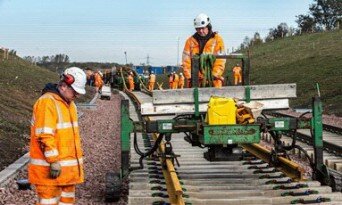 Not very amusing. A platform at Bank station in London with a 1-foot (30 cm) gap between the train and the platform edge. (Wikiphoto: Credit: CMglee)
Not very amusing. A platform at Bank station in London with a 1-foot (30 cm) gap between the train and the platform edge. (Wikiphoto: Credit: CMglee)
Network Rail to improve platform safety
Published: Tue, 2015-02-17 15:20Over the past five years rail passengers have walked on and off trains more than 15 billion times. While Britain has one of the safest railway in Europe, tragically during this time 18 people have lost their lives and almost 7,000 injuries have occurred following falls from the platform, or while boarding and alighting trains.
With passenger numbers growing year on year, companies thru the rail industry have worked to look up to 30 years ahead to detect and reduce any further risks to safety and published a joint long-term strategy. It aims to make the transition between the train and the platform safer, so that growing numbers of people can continue to enjoy a safe and better performing railway for years to come.
The gap between the train and the platform is designed to be practical. It must both be large enough to provide sufficient space for a variety of different train types to run safely and practicably without creating a physical obstruction but also be small enough to allow people to get on and off quickly and safely. The gap cannot be closed nor can it ever be exactly the same at all Britain's 2,500 stations, as they were built at different times by different historic railway companies.
There are a number of factors which contribute to accidents between the platform and trains and analysis shows:
Intoxication: More men are involved in alcohol related incidents than women with 9% of all incidents involving intoxication.
Baggage: 15% involved passengers carrying suitcases, pushchairs, bikes or other baggage
Gender: More females than males (around 65%) are involved in accidents alighting or boarding trains. Footwear could be one reason for this difference. It is also possible that females are more likely to report this type of incidents.
Age: Women aged 50-71 experience the highest number of incidents while boarding and alighting trains (more than 200 P/A)
Location: Alighting the train is more hazardous than boarding
The network is made up of 2,500 stations, all with different layouts, built at all different times over the past 180 years, with different types and designs of trains and different and changing passenger needs.
As part of the strategy, a public awareness campaign, backed by the rail industry including Network Rail and train operators, has been launched in stations across Britain. Called, "Lend a Helping Hand" it uses quirky verse to encourage people to be more considerate of their fellow passengers. An internal industry campaign also aims to help railway staff better identify those passengers in need
Source. Network Rail

Av Markku Björkman
Related News
Relevant Content



























































































